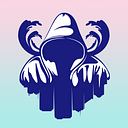The “Mass Ownership” Ruby Model: A New Era in Web3 Play-to-Earn Gaming.
By: 0xGroth.eth | BOGG
As the owner of a leading gaming guild in the industry, with extensive research into play-to-earn projects, significant holdings in Heroes of Mavia, and also the leader of the game’s largest Alliance. I believe Heroes of Mavia’s “Mass Ownership” Ruby Model is a unique industry innovation. Here’s a concise overview:
Web2 and Web3 Synergy: Mavia seamlessly integrates Web2 with Web3. Legendary Items can be purchased using Stripe, facilitating transactions via Apple Pay, Google Pay, Visa, and PayPal. When Web2 users make transactions, Web3 players get paid in $ETH. This fosters a symbiotic relationship that, for the first time in Web3 history, allows asset holders to earn from transactions made on the Web2 side of a game.
Advanced Land Renting: Mavia’s revamped land renting system allows rentals using $ETH, Ruby, or $MAVIA. This provides stability and flexibility, reducing the typical volatility of play-to-earn models. With NFT lands generating significantly more Ruby than any free-to-play land, the demand from both competitive and casual players to partake will be immense.
Overcoming Play-to-Earn Challenges: Mavia’s model addresses traditional play-to-earn challenges, ensuring sustainability and app store compliance. The model recognizes that incentives alone cannot sustain a game’s economy; equilibrium is essential, as highlighted in the article announcing this model.
Ruby and Value of Legendary Items: ‘Ruby’ is the in-game currency, while ‘Legendary Items’ are NFTs. These items, especially the Legendary Consumables and Statues, can influence game progression. The Ruby marketplace showcases skins, land decorations, statues, and exclusive Legendary Consumables. As players aim to optimize their base for competitive play or simply for personal achievement, these consumables will be highly sought after.
Skins and Cosmetics Potential: Although Legendary Consumables and statues are expected to be the main attractions, the potential of skins and cosmetics is vast. Given the game’s potential reach, these items could present enormous opportunities for landowners, especially considering the historical demand for skins in many other popular games.
Inclusive Economy: Ruby, being accessible to all players, prioritizes player engagement over speculative trading. This model could bridge the gap between Web2 and Web3; other projects are anticipated to draw inspiration from this.
App Store Compliance & Mass Adoption: Mavia ensures wider accessibility by differentiating in-game Ruby transactions from external cryptocurrency transactions. This approach promotes mass adoption. While most Web3 projects target a niche Web3 player base, this model can function within established app ecosystems by emphasizing compliance.
Sustainability and Growth: As the player base grows, the demand for limited-supply Legendary items will increase, promoting a sustainable economy. Considering the points mentioned above, this model has the potential to rival the traditional gaming industry and amplify blockchain technology’s role in gaming. All of these benefits directly enhance Heroes of Mavia.
Consistency with Original Vision: The Ruby model, though evolved, retains its core principles:
- Landowners can profit from the Ruby marketplace: Instead of Ruby being the primary currency for all in-game transactions, it’s no longer a cryptocurrency, and Sapphire has been introduced. This has been a significant point of contention for landowners in the community, but it had to be done for compliance reasons, and all the other benefits shouldn’t be ignored just because of this change.
- They have a distinct Ruby earning advantage over F2P players: The exact amount is unknown, but it’s said to be significantly higher, creating a considerable way to give value to NFT land owners within the game.
- Landowners can still rent out their land: The demand for legendary consumables and statues will be high, so there will be a strong incentive to play on NFT lands that F2P players can use to earn significantly more Ruby to progress their original bases or delve deeper into the Web3 side and purchase their own NFT land.
Conclusion: The “Mass Ownership” Ruby Model establishes a new benchmark in Web3 gaming, combining sustainability, inclusivity, and a seamless experience. With its focus on items that influence the game progression and its harmonious integration of Web2 and Web3, Mavia’s approach provides a roadmap for blockchain gaming’s mass adoption. While innovation always carries risks, Heroes of Mavia has the potential to be remembered in gaming history for decades as the project that propelled an entire industry forward.
